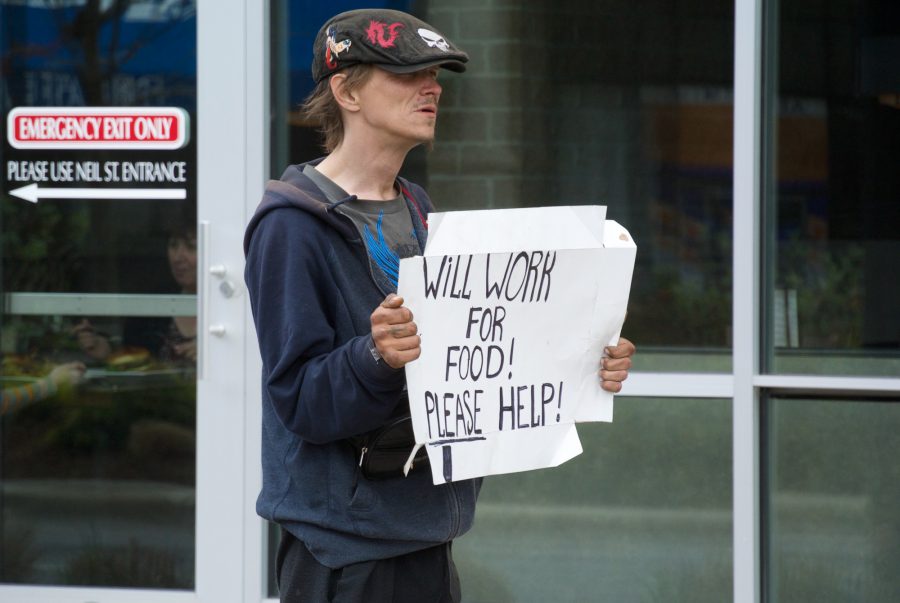Local homeless shelters hit hard by state budget cuts
Faraz Mirza | Staff Photographer
Panhandler “Ghost” flies a sign in Downtown Champaign on Wednesday, April 29, 2015.
Sep 25, 2016
With Campustown’s constant presence of homeless individuals, Rohan Prabhakar, a freshman in Engineering, believes the community must take notice.
“Considering the amount of resources available in Champaign itself, I think the city must be doing more to relocate these people,” Prabhakar said.
But the Champaign community has seen these resources evaporate. In 2016, the Salvation Army’s Stepping Stone Shelter and Community Elements’ Roundhouse Shelter closed. The Times Center, while remaining open, has had its capacity cut from 70 beds to just 20.
A staple of the community for nearly 40 years, the Roundhouse Shelter shut its doors in the spring. Community Elements, a local mental health agency, formerly operated the shelter.
However, the agency merged with mental health organization Rosecrance on July 1.
Get The Daily Illini in your inbox!
Like many social service agencies in the state, Community Elements faced drastic budget cuts, said team leader Russ Mullett. He connected funding cuts to state budget woes.
“This past year, we’re just not getting those funds coming in, which means the agency ends up pulling from other sources,” Mullett said. “But you can only do that for so long.”
Community Elements lost over one million dollars in state funding at the beginning of the year. This forced them to cut back on many services and operate through local funding. Ultimately, this is not enough.
“In Champaign-Urbana, the community just has very limited resources for emergency housing, or even for transitional housing programs,” Mullett said.
Rosecrance closed the emergency housing but kept the transitional housing. The program, designed for people between the ages of 17 and 24, is designed to help homeless youths get back on their feet.
“The overarching goal is self-sufficiency,” Mullett said. “These are youths who meet the government’s definition of homelessness and are struggling to make it on their own.”
Youth homelessness in particular has grown in the community. The United Way of Champaign County produced a new community report in 2015 which estimated that child homelessness has increased 132 percent in the last five years. This makes it important for Rosecrance to operate youth-oriented programs.
The homelessness issue seemed to be growing even before the shelters closed, Mullett said. This surprised him, due to the amount of services established in the local community to prevent homelessness.
However, the homeless issue isn’t something that’s new to the Champaign-Urbana area, said Lt. John Brown of the University of Illinois Police Department.
“I’ve been here 26 years, and we’ve always had homeless people asking for money,” Brown said.
He explained that the problem on campus was worse in the past. The aforementioned Times Center previously operated at McKinley, resulting in a constant population of homeless individuals living on campus.
He also said there once was a major problem with homeless people sleeping in campus buildings, which has since been eliminated.
Brown said the police generally leave the homeless in Campustown alone, though there are some exceptions.
“For the most part, most of the homeless and beggars don’t cause any problems,” he said. “But you do occasionally have issues.”
Most of these issues are not too serious, Brown said. It is mainly just petty theft. The homeless usually don’t cause violent crime, and simply exercise their constitutional right of free speech.
But that doesn’t mean that students shouldn’t remain alert, Brown said.
“There’s a student population that can be gullible sometimes, and there are some students who are more naive than others,” he said. “It’s a great place to ask for money. You’ll always find someone who’s willing to give it.”






